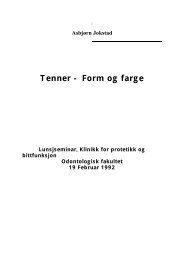Quality of dental restorations. FDI Commission Pro... - ResearchGate
Quality of dental restorations. FDI Commission Pro... - ResearchGate
Quality of dental restorations. FDI Commission Pro... - ResearchGate
Create successful ePaper yourself
Turn your PDF publications into a flip-book with our unique Google optimized e-Paper software.
128cement, composite resin/resinmodifiedglass-ionomer cementand resin-modified glass-ionomercement/glass-ionomer cement.Several studies have reportedcomparisons between ‘sandwich’versus homogeneous <strong>restorations</strong>,but the conclusions are conflicting.Patient factorsEmpirical observations indicate thatnot only surface, but also bulk andmarginal discolouration vary amongpatients. However, very few studieshave identified specific patientfactors that may influence the opticalcharacteristics <strong>of</strong> <strong>restorations</strong>.Marginal discolouration alongveneers made from compositeresin on 87 maxillary anteriorteeth in 23 young patients wasmore common among smokerscompared to non-smokers in alongitudinal study over five years 102 .In a study <strong>of</strong> 52 pairs <strong>of</strong> ClassIII micr<strong>of</strong>illed composite resin<strong>restorations</strong> after eleven years,surface discolouration was most<strong>of</strong>ten recorded among smokers,and significant correlations werefound between the patients’consumption <strong>of</strong> alcoholic beveragesand body and surfacediscolouration 88 .AdaptationTraditionally, the terms used todescribe adaptation have variedwith the examination method, thetype <strong>of</strong> restoration and the nature<strong>of</strong> the restorative material. Horizontaldiscrepancies on smooth andapproximal surfaces have <strong>of</strong>tenbeen termed ‘overhangs’, while theterm ‘marginal ditching’ has beenused to describe defects alongmargins on the occlusal surfaces <strong>of</strong>teeth containing mainly amalgam<strong>restorations</strong>. The terms over- andunder-extension, with additionaldescriptors <strong>of</strong> the cement marginmorphology, for example ‘marginalwear’ and ‘cement excess’, haveusually described the adaptation <strong>of</strong>indirect <strong>restorations</strong>. Finally, theterm ‘gap’ has also been used formany years to infer a lack <strong>of</strong> adaptationbetween the materials andtooth tissues. However, this term israther ill defined and non-specific.Discrepancies measured alonga horizontal or a vertical axistangential to the interface haveoccasionally been interpreted assynonymous to marginal adaptation.Such discrepancies can beassessed clinically, but will necessarilyonly express the adaptationalong the margin on the toothsurfaces. Several methods havebeen used to assess adaptation <strong>of</strong>the entire restoration-tooth interface,but all these methods aredestructive 103 .The clinical evaluation <strong>of</strong> marginaldiscrepancies is questionable,explained by a lack <strong>of</strong> reliablediagnostic skills <strong>of</strong> clinicians. It hastherefore been argued that thescientific community must acceptthat <strong>dental</strong> restorative materials willbe misjudged during the process<strong>of</strong> evaluating the marginal qualities<strong>of</strong> <strong>restorations</strong> 104 .Material factorsThe <strong>dental</strong> literature containsnumerous papers in whichmarginal degradation has beenevaluated as a function <strong>of</strong> materialcomposition. The prevailing materialin these studies has been amalgam,and there is consensus that highcopperalloys are clinically superiorto low-copper alloys 105 .Inter-group differences in respect<strong>of</strong> the marginal degradation <strong>of</strong>amalgam <strong>restorations</strong> <strong>of</strong>ten appearafter a short time, and remainconstant 29,69,106–109 . This signifies thatat least one process that results inmarginal fractures occurs duringthe first year after placement <strong>of</strong>the restoration. This hypothesis,however, does not identify orexclude other aetiological factorsthat may be associated withmarginal fractures, including creep,mercuroscopic expansion, biomechanicalrelationships, bulk andcrevice corrosion or fatigue rupture.There may also be differencesbetween composite resins, Bryantet al. 110 having reported thatparticular types <strong>of</strong> marginal defectsare commonly associated withspecific types <strong>of</strong> composite resins.In general, <strong>restorations</strong> <strong>of</strong> micr<strong>of</strong>illedcomposite resins show moremarginal degradation compared to<strong>restorations</strong> <strong>of</strong> other types <strong>of</strong>composite resins.Operator factorsJokstad 29 reported an influence <strong>of</strong>the operator on the performance<strong>of</strong> 468 amalgam <strong>restorations</strong> <strong>of</strong>five alloys placed in 210 patientsafter five years. The five dentistswere all able to obtain superiormarginal adaptation with the bestalloys, and contrary to the findings<strong>of</strong> Mahler and Marantz 21 , all fivealloys performed equally well forthe five operators. Further, it wasevident that one operator alsoobtained satisfactory marginaladaptation with a low-copperalloy. It was concluded that themain operator variables influencingthe marginal adaptation werethe final condensation <strong>of</strong> the amalgamand the treatment <strong>of</strong> thesurface and margins.Mahler and Marantz 21 reportedon <strong>restorations</strong> <strong>of</strong> four amalgamalloys placed by four operators.The amalgams were chosen on thebasis <strong>of</strong> their marginal fracturebehaviour as found in an earlierstudy, ranging from little to extensivefracture. Following placement<strong>of</strong> the <strong>restorations</strong>, three-yearevaluation <strong>of</strong> marginal fracture wasundertaken using a linear ratingscale. It was found that the operatorinfluenced the marginal fractureindex, but in different waysdepending on the alloy. For thealloys with the most and leastmarginal fracture, there was nooperator difference. However, forthe two intermediate alloys, therewere large differences among theoperators. Overall, the associationwith alloy was stronger than withoperator, and it was thereforeInternational Dental Journal (2001) Vol. 51/No.3


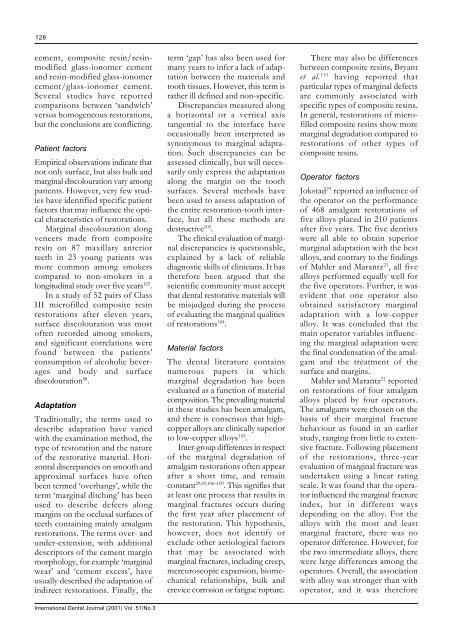
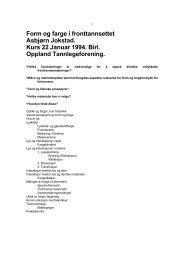
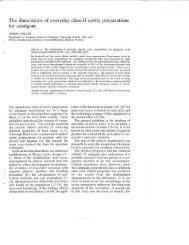
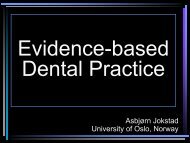
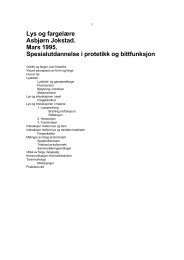
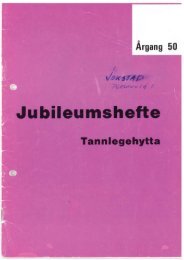
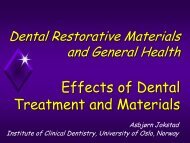
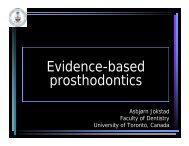

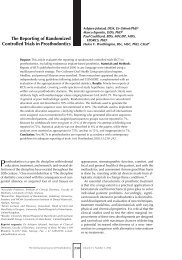
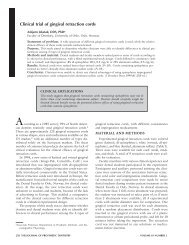

![[Sementer i fast protetikk] Scandinavian Society for Prosthetic](https://img.yumpu.com/18378889/1/190x245/sementer-i-fast-protetikk-scandinavian-society-for-prosthetic.jpg?quality=85)
